by Heather Plett | Feb 20, 2013 | Beauty, grief, hope, Uncategorized
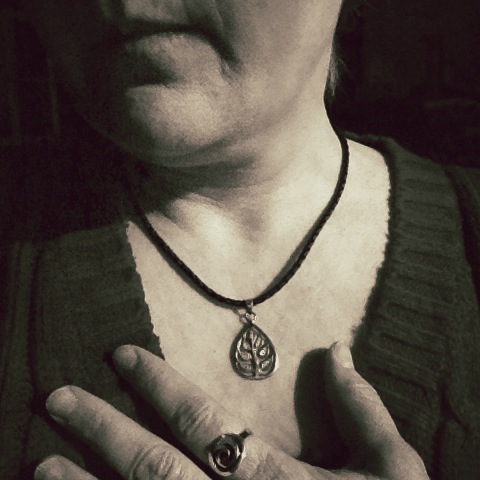
I wanted to find hope again. I really, REALLY longed for it.
I wanted to have some hint of what it will be like when I no longer feel buried under the grief of Mom’s death and the added trauma of Marcel’s heart attack and the accompanying financial stress, extra workload on my shoulders, etc., etc.
I know that “this too shall pass”. It’s what I cling to every time I find myself spiralling down into the hard places in life. “I’ve been through this before. I know that I can survive. It will get better.”
When I found the necklace in Ten Thousand Villages, I knew that I’d found my symbol of hope. It’s a tree of life, crafted by artisans in Cambodia out of the shell casings of bombs that litter the countryside. Perfect. Creating something beautiful out of destruction, loss, and grief. Making the land safe again by cleaning up the unexploded land mines and making them into jewellery. Hope out of hardship. Sounds pretty close to what I specialize in.
“…and they shall beat their swords into plowshares, and their spears into pruning hooks: nation shall not lift up sword against nation, neither shall they learn war any more.” (Isaiah 2:4)
I texted Marcel a photo of the necklace. “Don’t you want to buy me something for Valentine’s Day?” I asked. Sure enough, he did. He was in the store later that day and the necklace was mine. I was delighted.
Not only was it a little bit of hope to wrap around my weary neck, it felt like a new trademark for the work I do with clients. “You too can find beauty in the grief and destruction of your lives. You can rise out of the brokenness and be courageous, resilient, and authentic. You can find deeper connection and more honest stories when you clean up the land mines and turn them into necklaces.”
And then, two days later, the necklace was gone. I stood in the bookstore bathroom, looking down at the chain on the floor. There was no tree of hope attached anymore. Somehow, somewhere, it had slipped off my neck.
I searched everywhere, but it was nowhere to be found.
Instead of holding my head up high and telling myself it was “just a necklace,” I took a nosedive into self-pity and hopelessness. “What the hell, universe? Do you hate me? Do you really want to take away the one thing that was giving me a bit of hope in all of this hardship?”
It was on my dad’s birthday that I lost my necklace. He would have been 79. Right there in that bookstore washroom (where I returned after retracing my steps throughout the store and into the parking lot), I sat and wept for all of the losses and grief stories in my life. The necklace was just the symbol (and the proverbial straw that broke this camel’s back) of everything else that has been lost in the last dozen years – my dad, my mom, my son, nearly my husband (twice)… and so many more, smaller losses. I wept and wept and let myself feel the weight of all of that grief.
And then the next morning, on my way to work, I had a car accident. Yes, really.
It was a minor car accident and nobody was hurt and there is only very minor damage to my car, but it felt like my whole world had fallen apart.
I sat in my office and cried some more. And raged at God. And cried some more. And raged. And cried. And then I got up, and moved my body a little, said a little prayer of gratitude that I hadn’t been hurt… And then… somehow… I carried on. I finished preparing for the workshop I had to deliver yesterday and then went out to the rural town where I was delivering it. I sat in circle with the women in the leadership program I’m co-hosting, and I let the conversation and the compassion in the room offer me a little bit of healing.
When I got home late last night, Marcel met me at the door holding a tiny silk package. Inside was another tree of hope necklace. He’d gone back the the store, told them about the clasp that had come undone, and they replaced it.
And now I’m wearing hope around my weary neck again – a neck made newly stiff from a slight case of whiplash, but a neck that is resilient and strong and will continue to hold my head up high when it needs to, and let it fall to my hands in tears when that’s what needs to happen.
I don’t have a neat little bow to tie this post up with. Life hasn’t become magically easy, and I still feel a little shaky and weepy, but this morning I am reminded that the real hope comes not from anything I can buy or wear. The real hope comes from the relationships that support me – my husband who cares enough to replace the necklace (and so much more), strangers at the store who were compassionate enough to believe him, the women in the circle who let me be authentic in their presence, my co-worker who let me be a little more broken apart than usual yesterday, the woman in the accident who thanked me for my courage in standing up to the man who caused the accident but refused to take personal responsibility, my friends who sent kind messages… and God, the source of my strength, who doesn’t promise ease, but promises courage if I dare to trust.
If another tragedy happens tomorrow, I might fall apart again, I might rage and scream and wallow in self-pity, but then I will get up off the floor and continue to make swords into plowshares. Because hope is still worth striving for. And love is still better than war. And light is still better than darkness.
And the tree of life grows best in the compost of the fallen trees of years past.
by Heather Plett | Feb 14, 2013 | Uncategorized
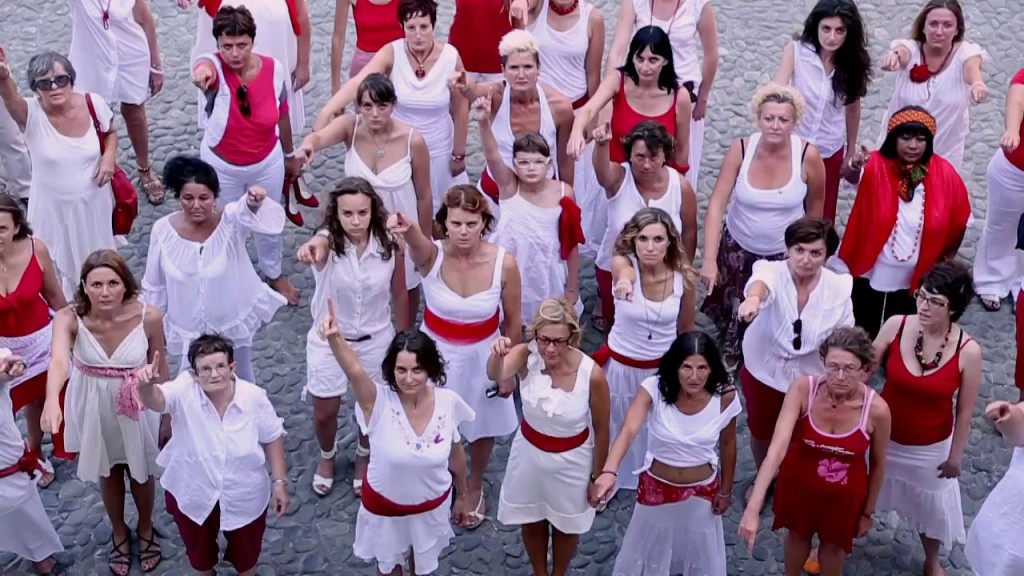
I am rising for the 21 year old girl I was when the man, high on glue, climbed through my bedroom window, held a blade above my head, and raped me.
I am rising for the many, many times since then that I have struggled with intimacy because my first sexual experience was a violent, ugly one.
I am rising because of the way that my culture, religion, and family history taught me not to trust or love my own body.
I am rising because I don’t want any more young women to grow up feeling objectified or unvalued.
I am rising because I don’t want any more young men to grow up feeling like they have to be “tough” to be “real men”.
I am rising because patriarchy has left deep wounds in me and every woman and man on the planet.
I am rising for the young woman in the yellow sari in India whose vulnerable eyes told the story of the betrayal she’d suffered after being sold into sexual slavery and then being told she was no longer worthy of being welcomed back into her family.
I am rising for the bead-adorned young women in Ethiopia who laughed and danced and worked hard in the mud alongside the men, and then suffered (and some died) under the dirty knife that ravaged their genitals.
I am rising for the sister-of-my-heart whose deeply buried memories of childhood sexual abuse have left her staggering and trying to catch her breath.
I am rising because each of us – the billion women who have been victimized – needs to heal and needs to be reminded that we are not alone.
I am rising because there is strength in numbers, strength in our bodies, strength in community, and strength in vulnerability.
I am rising because rape has become a weapon of war, a way to hold onto power, a way to keep women silent, and the way we treat our Mother Earth.
I am rising because our whole planet needs to heal from rape.
I am rising to bring forth the deeply buried feminine that the world so desperately needs right now, not to replace the masculine but to stand alongside in balance and strength.
I am rising for you and for me and for our daughters and for our sons.
I am rising for hope.
Will you rise?
(image credit: https://vimeo.com/49860523)
by Heather Plett | Feb 6, 2013 | change, circle, Creativity, Leadership, women
I have the great privilege these days of co-hosting a women’s leadership program that meets every second week in a small town an hour and a half from the city where I live. There are so many things about this that I love, including the fact that I have a regular reason to drive out into the country and see the wide open prairies and the wild, alluring woods. With no parents left to visit, I don’t get out to my rural roots often enough to suit me.
On the drive out there yesterday, we had a rare and wonderful sighting of a lynx as it dashed across the road and ran off into the snowy woods. It felt like a moment of blessing.
Yesterday’s session focused on facilitating change. The best change process I know of is Theory U, a process I was first immersed in at ALIA Summer Institute and that I’ve been a dedicated student of since.
I introduced the idea of a Change Lab, where-in we would walk through the U process by casting ourselves in the role of community leaders who recognize the need for change in how the community is organized.
I started out by sharing the story of Baba Yaga’s House in Paris, France, a home created for aging feminists by a circle of women who realized that none of the available models for seniors’ housing fit with their values or expectations of how they wanted to live. (I encourage you to listen to the podcast at the link above.) “Imagine we are these women,” I said. “We are faced with an established community model we know doesn’t work for us, and yet we haven’t found a new model that we’re comfortable with.”
From there I moved on to an explanation of Theory U, a method for co-creating social change. Instead of trying to find a direct route from challenge to solution – the way some of the more linear models do, with brainstorming, strategic planning, etc. – Theory U takes us on a deep dive into the unknown. Instead of trying to direct change, we host what is wanting to be born. Instead of trying to control, we let go and let come. Instead of expecting the future to look like the past with just a few tweaks, we invite a new future to spiral up out of the brokenness of the past.
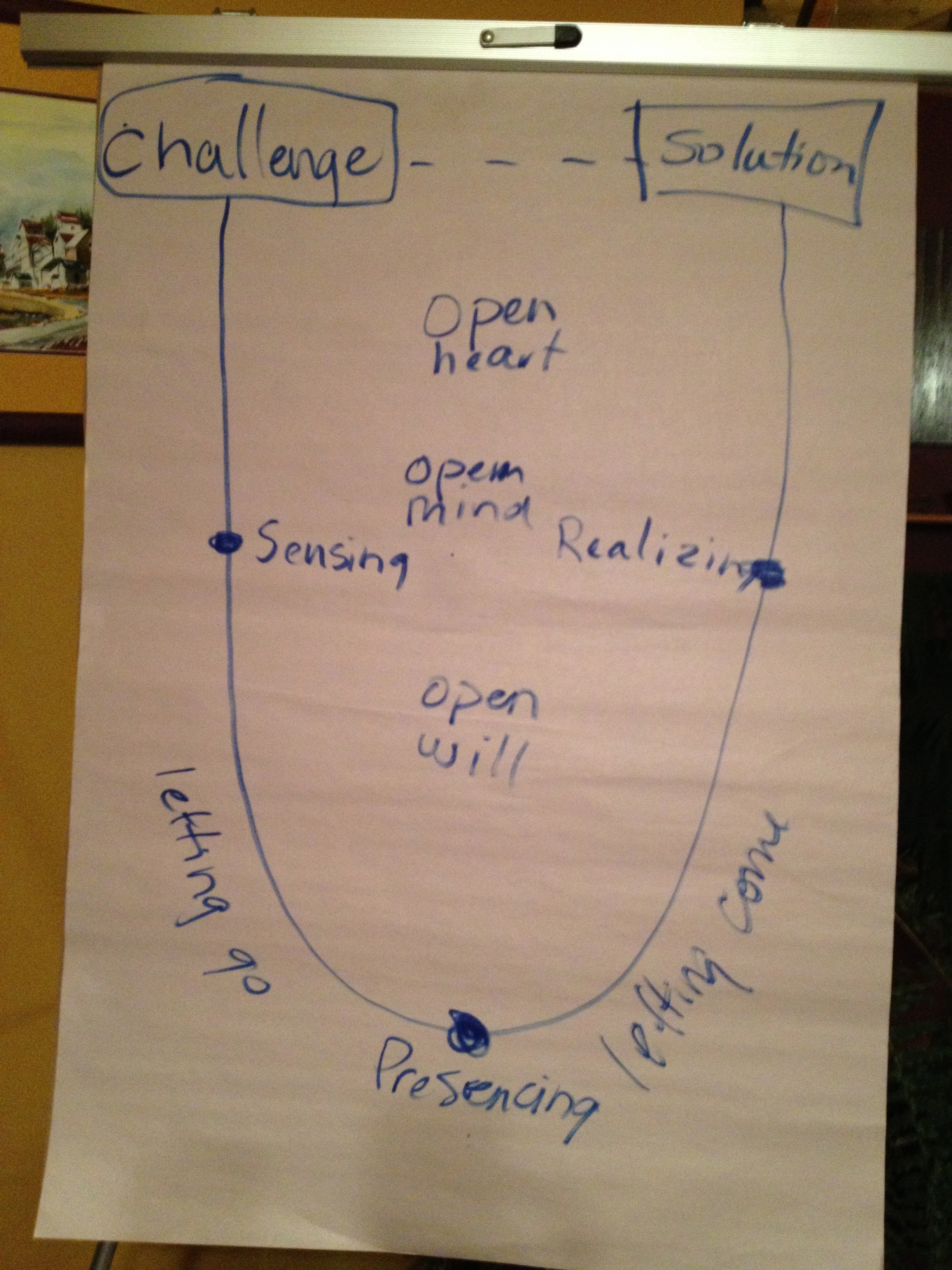 In Theory U there are three main parts – sensing, presencing and realizing. In the sensing phase, we are invited to use all of our senses to witness what is present. We are invited to suspend our judgements, opinions, assumptions and mental models, and to use our eyes and ears and the feeling of our bodies to sense into whatever the context is. We host conversations, we ask good questions, we listen deeply, we watch with full attention, and we notice how our bodies feel.
In Theory U there are three main parts – sensing, presencing and realizing. In the sensing phase, we are invited to use all of our senses to witness what is present. We are invited to suspend our judgements, opinions, assumptions and mental models, and to use our eyes and ears and the feeling of our bodies to sense into whatever the context is. We host conversations, we ask good questions, we listen deeply, we watch with full attention, and we notice how our bodies feel.
In the presencing phase, we are invited into the inner work of grounding ourselves in our bodies and paying attention to what is emerging. We listen into the space and learn from the future as it emerges, letting go of our expertise and experience. Rather than moving directly into problem solving or brainstorming, we take time for retreat and reflection. The best place for presencing is outside in nature where we ground ourselves in the earth and lean into the trees.
The third phase is Realizing. In this phase – on the upward movement out of the U – we “let come” what wants to emerge. We bring insights, sparks of inspiration, and crystals of ideas into prototypes. We move into action quickly and create small projects that can move the vision forward.
When I introduced Theory U to a women’s circle in Ontario last year, someone pointed out that I’d just drawn a woman’s breast. She said it with laughter, but when we started to unpack that, we realize that there was resonant truth to what she witnessed. This process definitely has a feminine aspect to it (as is laid out in this article by Arawana Hayashi) and it relates well to an infant suckling at the source of his/her life. It’s about going back to Source, it’s about seeking nurturing and rebirth, and it’s about the kind of rest and retreat that a mother must seek every few hours when an infant needs to suckle. It’s about being innocent, vulnerable, uneducated, without judgement, and open to a new future, just like that tiny baby. Since that first observation, I’ve brought up the idea every time I introduce it, and it always opens up interesting dialogue.
Once I had introduced the Theory, it was time to move into practice. To start with, I did one of my favourite things to do in workshops – I dumped a pile of garbage on the floor (things I’d gathered from my household recycling bin). “This,” I said, “represents the chaos and brokenness of the systems that no longer work for us. Out of this, something new wants to emerge, but we don’t yet know what it is. It will be up to us to host that new thing into being, without relying on what was or casting judgement on the ‘way it’s supposed to be’.”
In the Sensing phase, I asked them to sit in one-on-one conversations with a few different people in the room. “Ask deep questions, explore what is present, and use your senses to witness what is. Suspend judgement and don’t rely on past or second-hand information.”
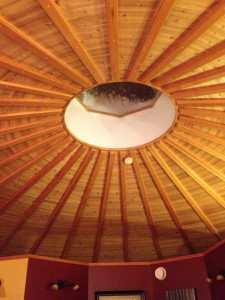 After a few rounds of conversation (too short, but all the time we had), they were invited to move into Presencing. “If it weren’t a cold winter night outside,” I said, “I’d encourage you to move outside for this part. Instead, find a quiet place inside where you can be alone with your thoughts and with whatever wants to emerge.” (As an aside, it felt beautifully appropriate that we were gathered inside a mandala home, a circular home built with great intention around honouring the four directions, giving space at the centre, and blending into the beauty of nature that surrounds it.)
After a few rounds of conversation (too short, but all the time we had), they were invited to move into Presencing. “If it weren’t a cold winter night outside,” I said, “I’d encourage you to move outside for this part. Instead, find a quiet place inside where you can be alone with your thoughts and with whatever wants to emerge.” (As an aside, it felt beautifully appropriate that we were gathered inside a mandala home, a circular home built with great intention around honouring the four directions, giving space at the centre, and blending into the beauty of nature that surrounds it.)
The next phase brought them back to the garbage on the floor, where they began to explore what wanted to emerge. Some felt stuck and really didn’t connect right away with the garbage on the floor. Others were eager to jump in and host the emerging future. Before long, though, everyone had made a valuable contribution to the scale model of the new community that wanted to be born.
We spread our community out on a large piece of cardboard on the table. Some pieces represented a connection with nature, others represented a connection with our neighbours, others represented a connection with opportunities/arts/beauty/etc., and still others represented a deeper connection with self and the sacred.
When we sat discussing the panorama in front of us, we realized that the resounding theme of what was emerging was connection. We were all longing for connection – with each other, with the earth, with the water, with the Sacred, and with ourselves.
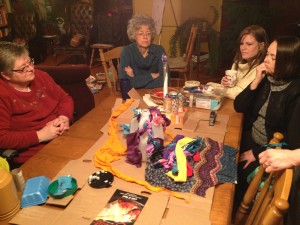 One woman asked “If recycling is the bi-product of a culture of consumption, what can replace consumption as our dominant paradigm that will no longer have a requirement for recycling?” Connection, we agreed. We need deeper connection.
One woman asked “If recycling is the bi-product of a culture of consumption, what can replace consumption as our dominant paradigm that will no longer have a requirement for recycling?” Connection, we agreed. We need deeper connection.
Before we departed for the night, I invited the women to consider (in their private moments, when they were back in their homes) “How might each of us be ambassadors for connection in our communities? How might we begin to invite this future into the circles in which we live?”
The women left with new lights in their eyes that hadn’t been there when they’d entered the room – all because of a pile of garbage and a time of connection.
(Next week’s session flows beautifully out of this… We’ll be talking about making connections in women’s leadership circles, using the new toolkit created by my teachers Christina Baldwin, Ann Linnea, and Margaret Wheatley.)
Note: If you want more inspiration on this, visit Presencing Institute, read Theory U, Presencing, or Walk Out Walk On.
by Heather Plett | Jan 28, 2013 | grief, growth, Uncategorized
Last Thursday morning, our life was thrown into turmoil again. Marcel woke me up at 3:33 a.m., complaining of chest pains. I rushed him to the hospital, and within a few hours they’d confirmed that he’d had a heart attack and would need a procedure of some kind (either surgery or angioplasty) to open the blockage in his arteries.
Fortunately, they were able to treat it with angioplasty – an amazing procedure in which they push a tube through a hole in the artery in his wrist all the way to the heart, inflate a balloon at just the right spot and install a stent that’s the size of a pen spring. His arteries are flowing the way they’re supposed to again and he just has to take it easy for a month or so to let the damage to his heart heal (plus work on some diet changes that will hopefully help prevent it from happening again).
After bringing him home from the hospital yesterday, I had to dive back into work mode, marking exams and then teaching all day today. Life goes on.
Today, after a full day in the classroom, I came home feeling weak, shaky, and kind of weepy. I think the trauma of this past week is settling into my body. The first thing I did was take a hot bath.
My emotions have run the gamut this past week. Anger that this had to come so soon after losing Mom; frustration that it came just when my business has picked up and I don’t have a lot of time to pause; fear that this could happen again and next time we won’t be as lucky, wonder that modern medicine can do such amazing things; resentment that other people seem to have ease in their lives while mine is full of struggle, gratitude that I have wonderful friends who bring me food, chai, wine, and love; and so on and so on.
This crisis felt doubly hard because I found myself intensely missing my mom all week. Normally, she would have been the first person I would have called, and she would have rushed to the hospital to nurture both me and Marcel. It’s what she did best. I long for her nurturing, and I suppose I always will.
I long for a day when life doesn’t feel this hard. I long for the day when I can write happy posts instead of these heavy ones again and again. I long for ease and abundance – two things that feel illusive right now.
Some day, I might look back and know what this all means, but I’m not at the point yet where I can tell you what lessons I’ve learned from this, or why it feels like I’m being asked to bear so much at once.
Right now, I’m still in the thick of the emotions and the learning will come later. Right now, I’m letting what needs to be felt simply show up without trying to judge it or give it a name.
Tomorrow will be time for learning. Today is time for just being present in what this is.
by Heather Plett | Jan 23, 2013 | circle
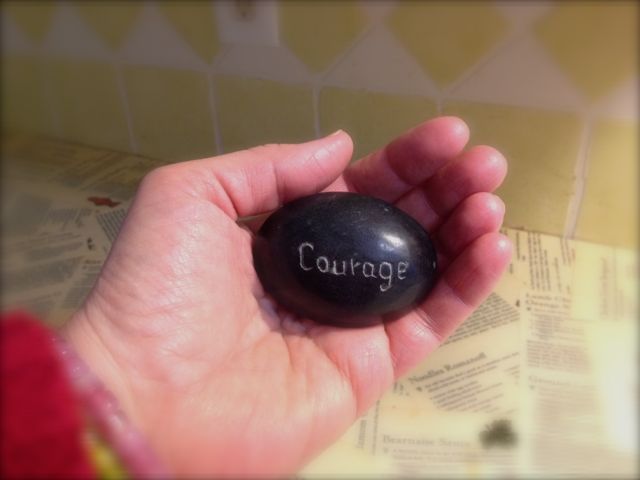
I’ve taken on the delightful task of co-hosting a women’s leadership learning circle that meets every second Tuesday in a rural community in our province. Yesterday’s circle focused on conflict resolution and difficult conversations.
We started the evening making collages that represented the things that we want to breathe out (release/stop doing) and breathe in (receive/embrace/learn) in relation to conflict in our lives. From there we moved into personal assessments of how we each respond to conflict. We talked about how each conflict is shaped by our level of commitment to the relationship and to the agenda at stake, and how we choose our conflict styles accordingly. The sharing in the circle was, as always, personal and intimate. There were stories of conflict in our workplaces, conflict in our marriages and family relationships, and conflict within ourselves.
At the end of the workshop, we asked the women to share what they had breathed in (received) and what they had been able to breathe out (release) throughout the course of the workshop. As they shared, we passed around a talking piece – the courage stone that was a gift from my friend Jo-Anne.
When the stone had completed the circle and returned to me, I said “it is always a pleasure to hold this stone after it has been in the hands of each of you in the circle. As it passes around the circle, it picks up energy from each of you, and that energy changes the rock. The colour becomes richer, and by the time it gets back to me, it is much warmer than it was when I first pulled it out of my bag. You have each given a piece of your energy to this circle and to this stone.”
Women’s circles are always the same. We bring little bits of courage, little bits of fear, little pieces of our stories, and little bits of our love. We pour it all into the container of the circle, we hold the edge for each other, and our offerings lend each of us a little bit more energy and courage than we put in.
It’s like a soup for which we each brought an ingredient. You may have only brought the carrots, but once the soup is done, once we’ve each had a chance to add our ingredients, we each have enough for a nourishing meal.
As we pass our stories around the circle, our courage grows and we all leave changed by the time we spent together.






